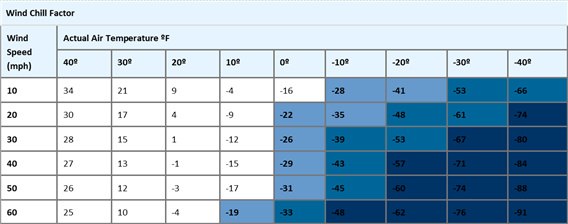By: Bobby McIlquham
November 2014
Cold weather is knocking on the door, and experts fear for yet another brutal winter. Winter weather can pose many dangers on the body ranging in all age groups. Whether you’re waiting for the bus or working your shift outside, braving the bitter temperatures can affect your body, so protection is essential during these critical moments.
Cold exposure can be uncomfortable, impair your daily routine and possibly become life threatening. Exposing yourself to cold temperatures associated with a wind chill can increase your chance to frostbite and hypothermia on the body. With that being said, here’s what you need to know to help you and others around you when old man winter hits.
Understanding Wind Chill
The Wind Chill index is the temperature your body feels when the air temperature combines with the wind speed. It is based on the rate of heat loss from exposed skin caused by the effects of wind and cold. As the speed of the wind increases, it can carry heat away from your body much more quickly, causing skin temperature to drop. When there are high winds, serious weather-related health problems are more likely, even when temperatures are only cool.
The Wind Chill Chart below shows the difference between actual air temperature and perceived temperature, and the amount of time until frostbite occurs

Frostbite times:
![]()
(Center for Disease Control and Prevention, 2012)
Identifying/ Preventing Frostbite & Hypothermia
Frostbite is the freezing of superficial tissues, usually of the face, ears, fingers and toes. Frostbite causes loss of feeling and color of within the affected areas that are exposed. If not treated immediately, individuals exposed to frostbite can result in amputation of the affected area(s). Hypothermia is a more serious condition in which requires immediate emergency attention since the body endures a significant drop in body temperature. Symptoms may include shivering, exhaustion, drowsiness, slurred speech and memory loss (CDC).
Clothing is crucial to preventing frostbite and hypothermia! Clothing is one of the most important parts of keeping you warm when performing activities in outside environments. Individuals should dress in layers and try to stay dry. Layers can be added or removed during temperature changes, activities and wind chill factors. Keeping you head/neck covered is critical when deciding what to wear before your day starts. Heat loss from the head and neck accounts to as much as 50% of total heat loss; therefore, the head and neck should be covered during cold conditions. Finally, it is best to keep an extra set of clothing with you nearby if you experience clothing to become wet. Hypothermia will set much quicker on the body if individuals leave areas of wet clothing on during long periods of time.
First-Aid: What you need to do if exposed
According to the Center of Disease Control and Prevention, if you believe you or someone near you begins experiencing symptoms of frostbite or hypothermia, perform the following:
- Provide immediate attention.
- Get the victim into a warm room or shelter.
- If the victim has on any wet clothing, remove it.
- Warm the center of the body first- chest, neck and groin.
- Warm beverages can help increase the body temperature.
- After body temperatures has increased, keep the person dry and wrapped in a warm blanket, including the head and neck.
- Get medical attention as soon as possible.
Temperature can change at any moment, especially in the Midwest; it is not unusual to go from warm and sunny to wet and cold! Protecting yourself in the harsh elements is essential during winter weather months. By following these helpful tips, you will not only keep warm, but reduce your chances of ending up in the doctor's office and even the hospital from treatment of frostbite or hypothermia.
Related Topics: Monthly Safety Topics, Safety Articles